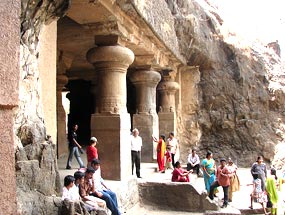Elephanta Caves are situated on Elephanta
Island, near the Mumbai city of Maharashtra. Read about Elephanta
Cave of India.
Elephanta Caves

Location: Near Mumbai, Maharashtra
Founded In: 6th-7th century
Status: World Heritage Site
Elephanta Caves are situated in the Elephanta Island hills, which lie
almost 11 km to the northeast of the Apollo Bandar of Mumbai. The caves
cover an area of 7 km in circumference and lie 7 km from the shore of
the mainland. The island is named after a gigantic elephant statue that
was found near its landing area. Presently, the elephant statue has been
kept in the Jijamata Garden of Mumbai. Numerous dynasties are said to
have occupied the Elephanta Island, namely Konkan-Mauryas, Trikutakas,
Chalukyas, Silaharas, Rashtrakutas, Kalyani Chalukyas, Yadavas, Muslim
rulers of Ahmedabad and the Portuguese.
Even the Marathas had control over the island, from whom it passed into
the hands of the British. Elephanta Caves of Maharashtra have been
carved out of a single piece of rock. The main features of these caves
include columns, internal spaces and beautiful images. Only some of the
rock surfaces here have been finished, while some are nothing more than
unfinished bare rocks. The Elephanta Caves date back to somewhere around
6th-7th century. There are a total of seven cave excavations in the
Elephanta group.
The most impressive amongst these caves is the Mahesa-murti cave (cave
number one). This cave represents advanced Brahmanical rock-cut
architecture. Even the beautiful and vivacious sculptures of cave number
one are worth having a look. The cave is very much similar to the Dumar
Lena (Cave 29) of Ellora. The main entrance of cave number one is
situated in the northern side. Apart from that, there are two openings
on the eastern as well as western side also. There is a central hall in
the cave, which is adorned with six rows of pillared columns.
In each of the row, there are six columns. The only exception is the
western corner, where a lingam has been enshrined. There are also three
large square recesses, divided by pilasters, and each of them has been
illustrated with an enormous image of the Dvarapala. The eastern panel
is ornamented with the image of Ardhanarisvara, a form of Shiva with the
combined energies of both male and female. On the western panel, one can
see the carved figures of Lord Shiva and His consort, Parvati, in which
both of them are playing chausar.
The central recess is known for housing the Mahesa-murti, the most
illustrious as well as most impressive sculpture of this period. The
sculpture is gigantic in size and represents the three different forms
of Lord Shiva. The first form is that of Aghora, which symbolizes a
tumultuous and formidable Lord Shiva. The second form is of Tatpurusha,
who is benevolent and is in a meditative posture. The third, and the
last, form is that of Vamadeva, signifying a mild agreeable and
endearing Lord Shiva.
Other prominent panels inside the main cave are those of
Andhakasuravada Murti, the cosmic dance of Nataraja, Kalyanasundara
murti, Gangadhara Murti, Ravana shaking Kailasa and Shiva as Lakulisa.
You should also see the panel near the eastern opening, which
illustrates Saptamatrikas. The Elephanta caves of Maharashtra are
believed to be the abode of Lord Shiva.


